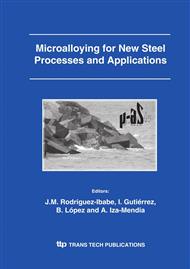p.495
p.503
p.511
p.519
p.527
p.535
p.543
p.551
p.559
Influence of Composition and Processing Conditions on Mechanical Properties and Fish-Scale Resistance of Microalloyed Steels for Double-Face Vitreous Enamelling
Abstract:
Hot- and cold-rolled steel sheets are the most important substrate materials for enamelling applications. Currently, industry is actively seeking ways to widen the area of application of hotrolled steel sheets for double-face enamelling. Another important task is search for new steel compositions that might substitute for currently used open-coil annealed, cold-rolled steel sheet for direct white enamelling applications. The purpose of this research project was the investigation of influence of chemical composition and processing conditions of several microalloyed steels on mechanical properties and fish-scale resistance of hot and cold rolled sheets. The results show that a high fish-scale resistance of the hot-rolled steel is achieved by creating a high volume fraction of fine precipitates (nitrides, carbides, carbonitrides, sulphides, etc.). By partial replacement of titanium with other carbide and nitride forming elements, such as niobium and/or boron, the suitability of cold-rolled IF steels for white direct-on enamelling can be remarkably improved without open-coil annealing. However, the processing conditions have to be tuned to ensure high fish-scale resistance without impairing formability.
Info:
Periodical:
Pages:
527-534
Citation:
Online since:
November 2005
Authors:
Price:
Сopyright:
© 2005 Trans Tech Publications Ltd. All Rights Reserved
Share:
Citation:


